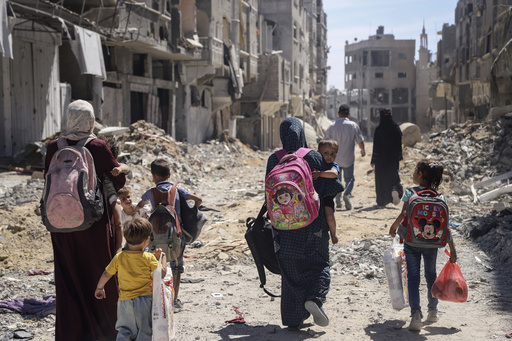
JERUSALEM — Prime Minister Benjamin Netanyahu of Israel is currently considering a controversial strategy aimed at restricting humanitarian aid to the northern region of Gaza, with the intention of weakening Hamas forces. If enacted, this approach risks leaving countless Palestinians—many of whom are unable or unwilling to evacuate—without access to essential food and water supplies.
Throughout the ongoing conflict, Israel has repeatedly issued evacuation orders for northern Gaza, the latest occurring last Sunday. The so-called “Generals’ Plan,” proposed by a coalition of retired military officials, suggests that Palestinians should be given one week to exit the northern area of the Gaza Strip, covering Gaza City, before the region is established as a closed military zone. Those who choose to remain would be deemed combatants under military guidelines, potentially exposing them to lethal military action and denying them vital resources such as water, food, medicine, and fuel.
The plan aims to enable Israel to assert long-term control over the northern Gaza sector, with aspirations of forming a new administration devoid of Hamas influence, effectively partitioning the Gaza Strip. However, the government’s commitment to the full execution of this proposal remains ambiguous, with officials noting that while sections may already be in operation, their specifics have not been disclosed. Some sources indicate that Netanyahu is actively reviewing the plan, among various others that have been presented during the conflict.
Recently, Israel intensified its military operations against Hamas supporters at the Jabaliya refugee camp, situated north of Gaza City. Since September 30, no humanitarian aid trucks, including those carrying food and medicine, have entered the northern region of Gaza, as reported by both the United Nations and the Israeli military’s humanitarian oversight authority.
The United States has publicly stated its opposition to any initiative that might lead to a direct Israeli occupation of Gaza, a sentiment that human rights organizations echo, fearing that the proposed plan would have dire consequences for the civilian populace. These groups emphasize that such actions could amount to starvation tactics, citing international law which expressly prohibits using food as a weapon or forcing population transfers. Claims regarding Israel’s restrictions on food supplies have become pivotal to allegations of genocide against it in the International Court of Justice, which Israel vehemently denies.
In light of the most recent evacuation orders, most Palestinians have chosen to stay in their homes for various reasons. Many individuals, including the elderly and those in poor health, aren’t able to flee, while others express concerns over the lack of safe havens. Previous evacuees have faced obstacles returning to areas they previously vacated, as Israeli forces have barred their re-entry.
“I think everyone in Gaza is scared of these plans,” said 26-year-old Jomana Elkhalili, an aid worker in Gaza City, who mentioned that many prefer to stay put. “They understand that the south isn’t safe either, often enduring airstrikes,” she stated, highlighting a pervasive fear among residents that any movement may lead to permanent displacement. “People in the north feel it’s preferable to face death than to abandon their homes.”
The consideration of this plan comes as Hamas maintains its operational resilience, launching rocket attacks into Tel Aviv and regrouping in different areas following Israeli military withdrawals amidst ongoing offensives. Following a year of brutal conflict with Hamas, Israel’s troop presence in Gaza has diminished significantly, with attention now shifting towards Hezbollah in southern Lebanon. Meanwhile, efforts toward a cease-fire remain elusive for both fronts.
According to Gaza’s Health Ministry, escalating military action has resulted in over 42,000 Palestinian fatalities, with the counts not differentiating between civilians and combatants, though it is reported that a significant portion of the deceased are women and children.
The “Generals’ Plan,” introduced to the Israeli parliament by retired military leaders last month, has elicited inquiries from Netanyahu’s office regarding specific details. The plan’s main architect, Giora Eiland, a former National Security Council chief, contends that restricting aid is essential to dismantling Hamas’s hold on the region. He remarked, “People will either need to surrender or starve. They won’t necessarily be killed; they simply won’t be able to survive there due to a lack of resources.” Eiland also believes this type of siege could compel Hamas to release the remaining 100 Israeli captives taken during the initial attack on October 7, with around 30 of those hostages presumed dead.
However, human rights advocates express deep concerns regarding the moral implications of converting civilians into legitimate military targets should they choose not to evacuate. “This idea that not leaving equates to becoming a military target is fundamentally flawed,” stated Tania Hary, executive director of Gisha, an organization focused on safeguarding Palestinian freedom of movement.
In light of the deteriorating conditions in northern Gaza, aid has all but disappeared, leaving many residents trapped amid a lack of vital supplies. The early stages of Israel’s ground offensive targeted northern Gaza, leading to immense destruction and mass displacement, with entire neighborhoods now in ruins. A senior U.N. official noted that very few aid shipments have been permitted since late September, with only a single small delivery of fuel for hospitals having crossed into the area.
Reports indicated that only around 100 people managed to evacuate the region following the latest military orders, as numerous barriers—such as checkpoints and infrastructure blockades—impede free movement between Gaza City and its northern outskirts. “We estimate that at least 400,000 individuals are stuck in this area,” stated Philippe Lazzarini of the U.N. agency for Palestinian refugees, emphasizing the alarming spread of hunger among the population.
As the humanitarian situation continues to worsen, both logistical challenges and a mounting crisis render the plight of individuals in northern Gaza increasingly perilous.
